
Elliott O’ Mara, our French specialist, has recently spent a week in Burgundy, visiting the growers and tasting the new vintage wines, here is what he had to say upon his return.
This year’s growing season has been tricky across Europe – our summer here in the UK was a bit of a washout. I’m sure you can imagine what that’s meant for our growers in Burgundy.
Wet weather throughout the season meant bad flowering and fruit set in spring. This develops into a condition known as coulure - undeveloped grapes due to unfertilised flowers, and millerandage - grapes of mixed sizes within the bunch - those affected are small and seedless, but less of a concern as they still ripen, but reduce overall yields. Furthermore, Chablis was hit with hail in May.
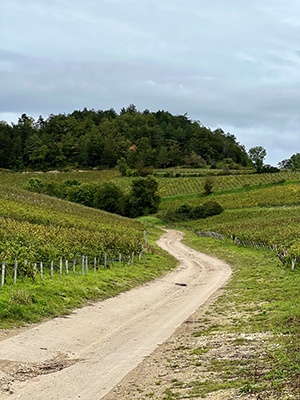 Chablis Grand Cru Vineyards - Malandes
Chablis Grand Cru Vineyards - Malandes
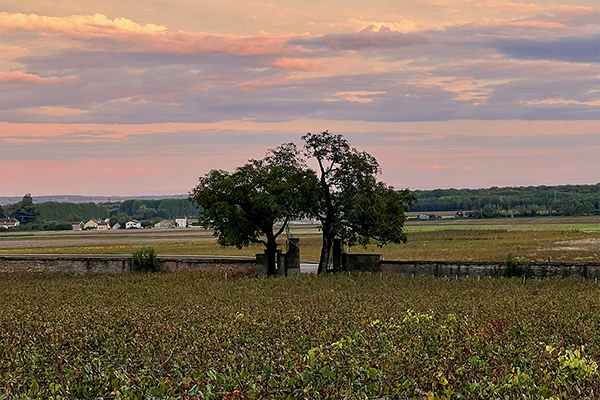
Domaine d'Arduy Clos des Langres vineyard
The wet weather across the greater Burgundy region from Chablis and the Côte d'Or, through the Mâconnais and down to Beaujolais continued throughout the season making ideal conditions for oidium and mildew. Organic growers’ treatments were repeatedly washed off by the rains, which means more work in the vineyards – it all sounds terrible – but it’s not! Our growers have managed to achieve reasonable yields, so for 2024, it will be another case of knowing your producers.
Every cloud has a silver lining, and considering the above, I’d say that it was the generous size and high quality of fruit that the 2023 vintage in Burgundy gave, and that was the main purpose of this visit to Burgundy. From what I tasted, reds and whites are good across the board.

Amandine and Guénolé Breteaudeau at Malandes
Domaine des Malandes
At Domaine des Malandes in Chablis, perfect conditions throughout the summer meant large bunches of healthy fruit arrived at the winery after picking commenced on 18th September. The wines showcase the region’s racy acidity and tension that are its hallmarks. Village level wines have the zippy, fresh character you’d look for, with 1er Cru and Grand Cru sites developing complexity of stone fruits and smoky mineral notes.
Reds from the Côte de Nuits and Côte de Beaune were incredibly approachable, from both barrels, and some early bottlings.
Domaine d’Ardhuy
Domaine d’Ardhuy’s cellars are the last property in the Côte de Nuits, with their monopole Closdes Langres vineyard walls signalling the border between Corgolion in the Côte de Nuits and Ladoix-Serrigny of the Côte de Beaune. They own vineyards from Gevrey-Chambertin down to Puligny-Montrachet, and excel at making wines full of bouncy, sweet, Pinot fruit that makes you smile the minute it is poured into the glass. Wines from their domaine and surrounding villages of Savigny and Ladoix show a particularly attractive character that are a pleasure to drink at any stage of evolution. Their village and 1er Cru whites from Ladoix deserve more attention and have historically flown under-the-radar, as they share the Corton hillside with vineyards that produce the legendary Grand Cru Corton-Charlemagne wines.
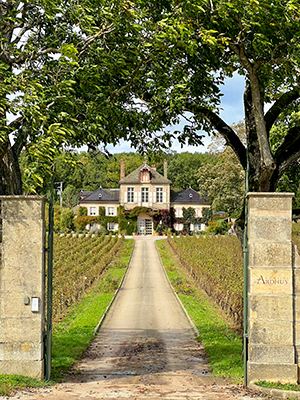
Domaine d’Ardhuy
Clos des Langres Gates
Domaine A.F. Gros
In Beaune, Domaine A.F. Gros hold a similar embarrassment of riches when it comes to top vineyard sites, including Richebourg, Echezeaux and Clos Vougeot, but are also known for their stunning village level Vosne-Romanee parcels, and more recently, the addition of Moulin-a-Vent. Mathias Parent and his sister Caroline Parent-Gros are the next generation vignerons. Mathias took over winemaking from his father François in 2013 after working side-by-side for three vintages.
2023 is the first year of a three-year experiment, raising 50% of Village and Grand Crus wines in ceramic vessels, the goal of which is to eliminate additional extraction of sulphur and tannin from used oak barrels – ceramic is neutral, easy to clean, and oxygenation of the wine is consistent.
The wines here have a delicate purity and signature Vosne-spiciness, with the ceramic vessels focussing the former and oak accentuating the latter. Finished wines should be excellent.
Caroline Parent-Gros in cellar
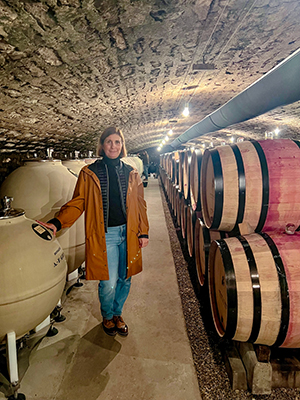
Domaine Bader-Mimeur
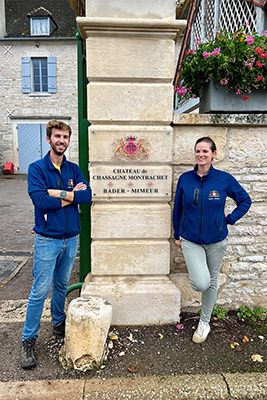
Nathalie Bernard & Sebastien Fosset
at Bader-Mimeur
The historic Château de Chassagne-Montrachet is home to Nathalie Bernard and the Bader-Mimeur family of winemakers. Her brother Sebastien Fossier is current winemaker and together they are the 5th generation at Bader-Mimeur.
Their 2024s are all bubbling away in the barrels and the majority of 2023s are in tank awaiting bottling. We will continue to offer their 2022s this year. All the wines are left to ferment naturally and this lasts about 1.5 months, though in the past (and cooler years) the wines’ fermentation will halt over winter and resume when things warm up in spring.
Bourgogne rouge and blanc (including their excellent Aligoté) are from vines opposite the property and are aged in old oak barrels. Village and 1er Cru wines see 20% new oak, with battonage every 3 weeks and in barrel for around 10 months. The jewel in the crown is their Chassagne-Montrachet “En Journoblot” which is village-level wine but sits across the path from Grand Cru vineyards Bâtard-Montrachet and Criots-Bâtard-Montrachet. If I were a Chardonnay vine, that’s where I’d want to be.
Maison Auvigue
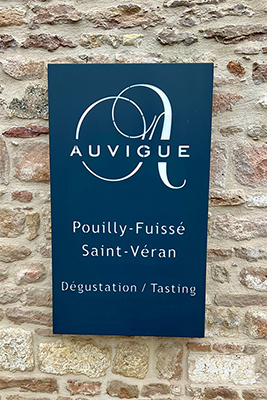
Headed down through the Mâconnais to the village of Fuisse, you’re surrounded by hillsides carpeted with golden-green Chardonnay vines after the harvest. Maison Auvigue is run by Sylvain Brenas, his great-grandfather started Auvigue as a merchant in 1946. The business expanded into winemaking later with vineyards coming from Sylvain’s mother’s side.
The new winery was built in 2017 and is housed within an old church in the centre of Fuisse. They have around 9ha of vines in total and purchase some fruit and juice for their wines, including their reds and Saint-Veran.
They own vines in nine 1er Cru vineyards, though only bottle four; the other small parcels are blended into a Pouilly-Fuisse 1er Cru cuvee. Wines are usually fermented with natural yeasts in either stainless steel tanks, or 300l oak barrels, depending on the cuvee and size. Generally, more new oak is used on the 1er Cru sites.
The unoaked Macon-Fuisse presents a crisp, lean and mineral character. As you work up through the range the fruit becomes plush, rich and spicy with an acidy that balances the use of oak and will keep the wines fresh for ageing in the bottle.
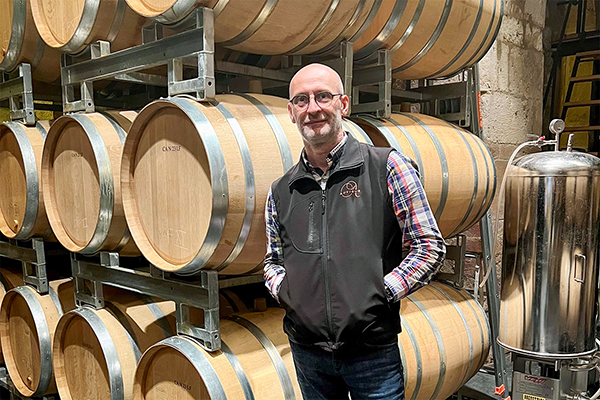
Sylvain Brenas-Auvigue at the Maison Auvigue Cellar
Domaine Des Marrans, Julien Duport & Richard Rottiers
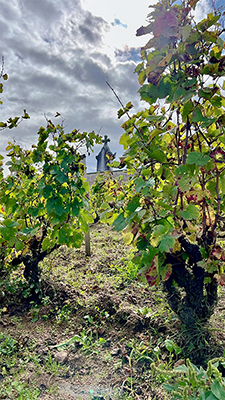
Richard Rottiers Dernier Souffle
From there, it’s only a short drive over the hills and into the Beaujolais region where clay and limestone give way to granite, schist and quartz.
To group these three producers together would ordinarily be doing each a disservice, but they are of a similar age, have similar approaches towine making and are also very good friends who share a love of the Gamay grape and its ability to express itself in so many ways…
Mathieu Mélinand of Domaine Des Marrans in Fleurie, Julien Duport in Brouilly and Richard Rottiers in Moulin-a-Vent.
They each use traditional semi-carbonic maceration for their fermentations, Mathieu and Richard are Organically certified, whereas Julien ploughs is oldest vineyard sites with a horse and cures saucisson and jamon from the cellar’s rafters.
Domaine Richard Rottiers
Whilst Mathieu and Julien are natives to the area, Richard is from Chablis. His mother’s estate is Domaine des Malandes and now run by his sister Amandine (see above). Marriage took him to Beaujolais and a three-year stint at Chateau Thivin (incidentally, Julien’s neighbour) which sparked his fascination with Gamay and its many characters. He set up Domaine Richard Rottiers in Romanèche-Thorinsin 2007 and has several very old vineyards across the Moulin-a-Vent appellation. He makes wines that can vary from crunchy and fresh, to structured and spicy, then a deeper coloured, smoky, bacon-fat style.
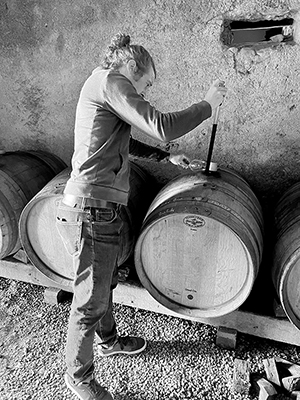
Richard Rottiers in Cellar
Domaine des Marrans
Mathieu’s wines are clean and precise, from vineyards in Fleurie, Morgon and Chiroubles. His father started Domaine des Marrans in the 1970s with their Clos du Pavillon vineyard and slowly grew it to 12ha. Now Mathieu and his brother Camille own 20ha of vines across these three villages.
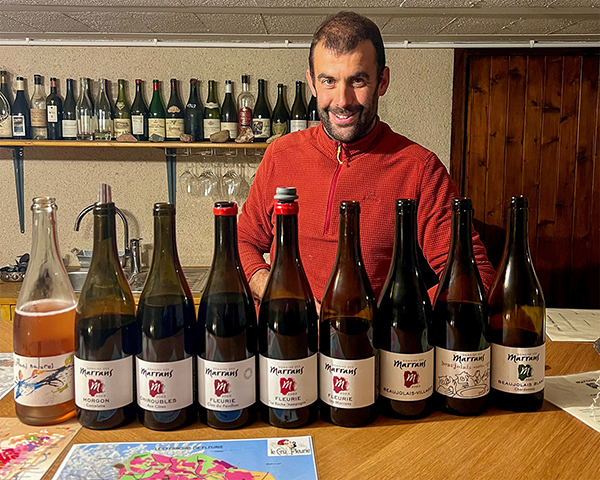
The maximum number of whole bunches are used where possible with natural yeast fermentations, avoiding the use of sulphur until the malolactic fermentation. The wines are racked once in spring and then settled for 6 months before bottling, unfined and unfiltered. Again, each cuvee has its own character, “Les Marrans” a little deeper and darker, the flagship “Clos du Pavillon” has more structure and concentration, whereas Morgon “Corcelette” is savoury and full of energy. All will age incredibly well.
Julien Duport
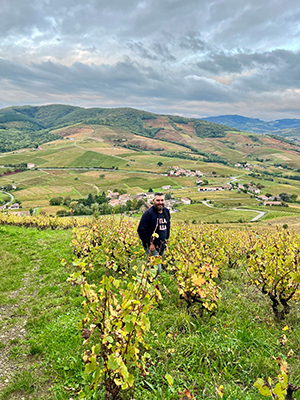
Julien Duport in Vineyard
Julien Duport has vineyards on both Mont Brouilly (Côte de Brouilly) and the opposing Mont Saburin (Bouilly). These are two very steep hillsides, where the mixed geology of the two sites makes for interesting wine – pink granite, schist, limestone and decomposing granite making up the coarse, sandy soils. Add 100+ year old vines into the equation and you know it’s good before you’ve even entered the cellar.
Natural yeast fermentations only sulphured at bottling. Filtration dependant on the vintage. Wines are raised in barrel, tank and foudre. Expect dark fruits, amazing acidity, and structure for ageing – but they taste good now! Its serious stuff. Don’t even start me on the special cuvee – “this is not Beaujolais” he says. No, it’s not. Tell me its Grand Cru Burgundy and I’d believe you.